
 |
The cyclopentadienyl (Cp) ligand is a monoanionic ligand with the formula C5H5. The first characterized example of a cyclopentadienyl complex was ferrocene, Cp2Fe, which has an iron atom "sandwiched" between two planar Cp rings as shown on the left. For this reason, bis(cyclopentadienyl) complexes are sometimes called "sandwich compounds" or metallocenes. Some metallocene derivatives, such as Cp2TiCl2, have their Cp rings tilted with respect to each other and are called "bent metallocenes", while complexes with only one Cp ligand have been colorfully described as having "half sandwich" and "3-legged piano stool" geometries. |
The discovery of ferrocene in 1951 and its structural elucidation by two separate research groups the following year marked the birth of contemporary organometallic chemistry. This revolutionary advance in organometallic chemistry was recognized with a Nobel Prize in Chemistry in 1973. Thousands of Cp complexes have since been characterized, and several of these form the basis for important industrial processes (see "Metallocenes For The Masses").
All of the first row transition metal metallocenes, Cp2M, have been synthesized except for titanocene, Cp2Ti, which has the unusual fulvalene-hydride structure shown below. As you can see in the following table, Cp ligands can stabilize metals in a variety of d-electron counts (as well as oxidation states other than 2+).
| Cp2V | Cp2Cr | Cp2Mn | Cp2Fe | Cp2Co | Cp2Ni | |
|---|---|---|---|---|---|---|
| Color | purple | red | amber | orange | purple | green |
| m.p. | 162 | 172 | 193 | 173 | 173 | 173 |
| d count # unpaired |
15 3 |
16 2 |
17 5/1* |
18 0 |
19 1 |
20 2 |
| M-C distance (Angstroms) |
2.28 | 2.17 | 2.38 | 2.06 | 2.12 | 2.20 |
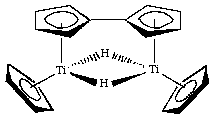
The normal bonding mode for Cp is  5 (pentahapto), for which several different resonance structures can be drawn for the bonding of an
5 (pentahapto), for which several different resonance structures can be drawn for the bonding of an  5-Cp ligand to a transition metal complex. The one on the right makes it easy to remember that a Cp ligand donates either 5 or 6 electrons to a transition metal complex (depending on which electron counting formalism you use) as it looks like one alkyl ligand + two alkene ligands:
5-Cp ligand to a transition metal complex. The one on the right makes it easy to remember that a Cp ligand donates either 5 or 6 electrons to a transition metal complex (depending on which electron counting formalism you use) as it looks like one alkyl ligand + two alkene ligands:

While some of these forms are important in special cases (see ring slips below), a molecular orbital (MO) diagram best describes the bonding in a Cp complex. Consider the five MO's of a Cp ligand. If we have two of these, we can add and subtract various orbital combinations to generate the MO diagram for a metallocene.
 .
.
The lowest energy orbital, a1, does not have any favorable overlap with any of the metal d-orbitals. It has little interaction with the dz2 because the ligand p-orbitals lie on the dz2 conical nodal plane. The e1g set of degenerate orbitals overlaps quite well with the dxz and dyz orbitals on the metal, forming a strong set of pi-bonds. The e1u interaction between the metal px and py also gives some stabilization. Although the metal dx2-y2 and dxy can overlap with the e2g orbitals on the ligand, the degree of overlap is not very large and these levels are essentially non-bonding.
The MO diagram for generic metallocenes, Cp2M is shown below. Notice that the Cp orbitals fill the six lowest orbitals. The next five unoccupied MO's shown in the box have little or no bonding character, which explains our observation above that metallocenes are known for a variety of d-electron counts.
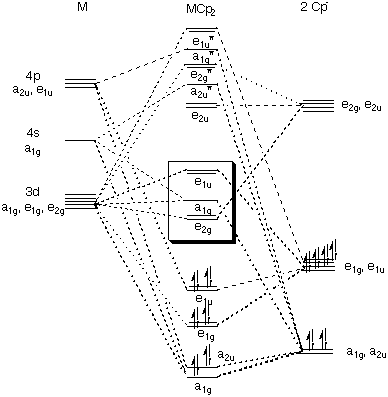
As one can infer from the MO description, most Cp complexes display completely delocalized bonding with equivalent C-C bond lengths in the C5 ring. The carbon-carbon bond distance of 143.3(6) pm in the Cp ring of ferrocene is somewhat longer than that observed in Na(TMEDA)Cp ( C-C distance of 138 pm) and other aromatic systems such as benzene (C-C distance = 135 pm). The longer C-C distance in ferrocene is the result of pi-backbonding from filled d-orbitals on Fe to the antibonding molecular orbitals on Cp.
While the C5 ring of ferrocene is planar, the hydrogens are bent downwards towards the metal by about 5 degrees. This can be ascribed to a canting of the p-orbitals on carbon which permits better overlap of the ligand MO's with the metal orbitals (see the MO diagram below).
The success of Cp ligands in contemporary organotransition metal chemistry can be traced to several key features:
A variety of substituted Cp derivatives are known, many of which have desirable steric, electronic or spectroscopic properties. The pentamethylcyclopentadienyl ligand, C5Me5 is one of the best known of these and has the designation Cp*. Cp* is sterically more demanding than Cp, allowing the isolation of Cp* complexes for which the Cp analogs are unknown or are kinetically unstable. In decamethylferrocene, Cp*2Fe, the methyl groups are actually tilted above the C5 plane by 3.4 degrees due to steric interactions.
The methyl groups on Cp* are electron donors, so this results in more electron density at the metal than for the analogous Cp complex. This can be observed spectroscopically by looking at carbonyl stretching frequencies of Cp/Cp* carbonyl complexes. The increased donation of the Cp* ligand results in greater pi-backbonding which is apparent from a red shift of approximately 50 cm-1 in the IR spectrum. Likewise, electrochemical measurements indicate that Cp* complexes are more easily oxidized than their Cp analogs by approximately 0.5 V.
A variety of other symmetric and asymmetric alkylated Cp derivatives have been prepared. For example, MeCp, C5H4Me, which is sometimes called Cp', is often used to impart subtle electronic differences to a complex or to make crystallization easier.
Finally, it is worth mention here of a ligand that has similar electronic donation properties to Cp. Tris(pyrazolyl)borate, commonly called Tp, is also a monoanionic ligand (B bears a negative charge) that donates six electrons to the metal center. Tp complexes are quite versatile and a wide variety of Tp derivatives with differing steric and electronic properties have been synthesized.
 /
/
In the 1H NMR spectrum, Cp rings appear as singlets in the range of 4.0 to 5.5 ppm. The barrier to rotation around the M-ring centroid vector is quite low (approximately 1 kcal/mol), so even though the molecule may possess low symmetry, all five ring protons are equivalent on the NMR timescale. In the 13C NMR, the carbons are also equivalent and typically appear between 80 and 95 ppm.
The methyl groups of a Cp* ligand typically appear at 1-2 ppm in the 1H NMR and 20-30 ppm in the 13C NMR.
Almost all syntheses of Cp complexes start from readily available (and inexpensive) dicyclopentadiene (b.p. 170 C). Upon heating, this undergoes a retro Diels-Alder reaction ("cracking") to afford free cyclopentadiene (b.p. 46 C) which can be distilled off as it is formed. The CpH can then be employed in several ways:
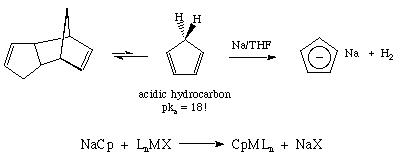
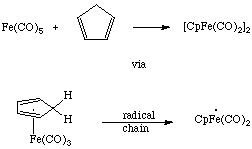
While the first route is the most general, NaCp is a good reducing agent and can make syntheses difficult. In these cases, TlCp (caution: toxic!) or Me3SnCp can be effective reagents.
Both the Cp and indenyl complexes shown below are 18-electron complexes that undergo simple ligand substitution via an associative mechanism. However, the rate for the indenyl complex is 108 greater than for the Cp analog!

This rate acceleration can be explained by a ring slip where the Cp ring moves from an  5 (pentahapto, i.e. bound through five carbons) to
5 (pentahapto, i.e. bound through five carbons) to  3 (trihapto, i.e. bound through three carbons) coordination. This reduces the electron count of the metal by two electrons, permitting an incoming ligand to coordinate without having to proceed through an unfavorable 20-electron intermediate.
3 (trihapto, i.e. bound through three carbons) coordination. This reduces the electron count of the metal by two electrons, permitting an incoming ligand to coordinate without having to proceed through an unfavorable 20-electron intermediate.
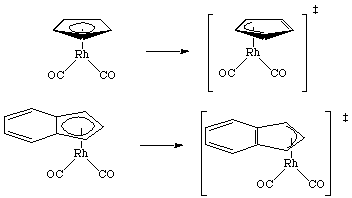
Notice that in the case of indenyl, the  3 intermediate is stabilized by the formation of an aromatic ring. This lowering of the transition state energy is responsible for the remarkable rate increase that is observed.
3 intermediate is stabilized by the formation of an aromatic ring. This lowering of the transition state energy is responsible for the remarkable rate increase that is observed.
Ring slips are common in late transition metal Cp complexes. Here's one example from Casey and coworkers in Organometallics 1983, 2, 535:
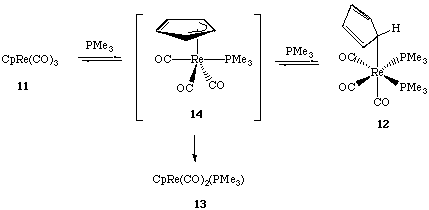
The monohapto nature of 12 has been confirmed by single crystal x-ray diffraction. Curiously, the NMR data do not suggest any unusual coordination mode in 12, showing only one signal for the Cp ring in both the 1H and 13C NMR spectra. As an  5 coordination mode would give a 22-electron complex, the only plausible explanation is that this complex is fluxional, rapidly hopping from one carbon to another. The barrier to this interconversion is so low that the fluxionality persists even at -87 degrees C! Complexes that undergo this rapid interconversion are called ring whizzers.
5 coordination mode would give a 22-electron complex, the only plausible explanation is that this complex is fluxional, rapidly hopping from one carbon to another. The barrier to this interconversion is so low that the fluxionality persists even at -87 degrees C! Complexes that undergo this rapid interconversion are called ring whizzers.
If you can't get enough of metallocenes, consider purchasing "Metallocenes : An Introduction to Sandwich Complexes" by Nicholas J. Long. You can purchase this text right now from Amazon.com for about $89.50.
A variety of introductory organometallic texts deal with Cp ligands and their applications in organic synthesis. Consult our Organometallic Reading Room for examples.